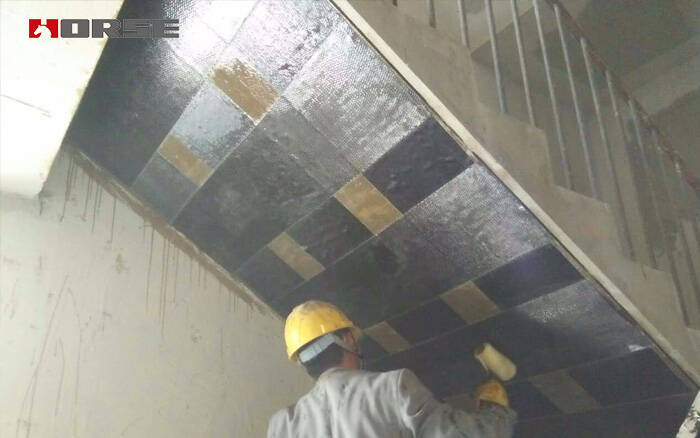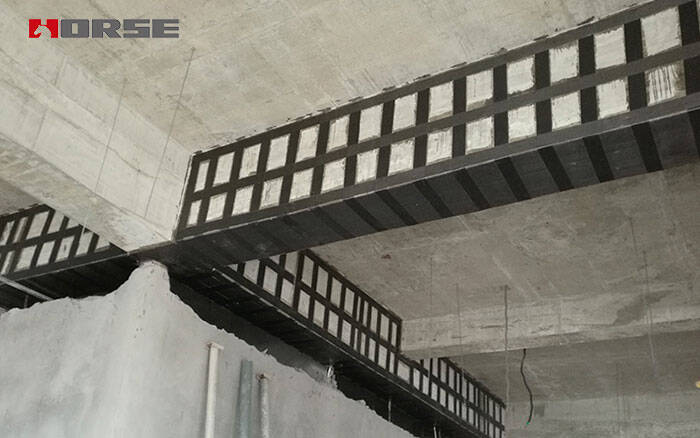Solutions
Horse Construction offers full range of structural strengthening materials with technical supports, documentation supports, products supports, project supports.
Carbon Fiber Fabric Reinforcement Technology In Structural Reinforcement

1 Reasons for structural reinforcement of common projects
a) Due to improper use, disrepair for a long time, damage to the structure, which cannot meet the current use requirements or insufficient safety, identification and reinforcement shall be carried out.
b) When the structure is cracked and damaged due to the impact of catastrophic events, the original structure needs to be identified and reinforced.
c) When a project quality accident occurs due to an error in the design or construction, the original structure shall be identified and reinforced. This situation may be encountered in both new construction projects and projects that have been completed and put into use. .
d) When some important historic buildings and monuments need to be protected, the structures should be identified and reinforced.
e) When rebuilding, expanding and adding floors to a building, the original structure needs to be identified and reinforced.
f) When a major change in the layout of structural components is required during the renovation of a building, which affects the original structural force system, the structure should be identified and reinforced.
g) When there is a deep and large foundation pit excavation near an existing building, and this kind of excavation will cause soil displacement and thus have harmful effects on the existing buildings around the foundation pit, these buildings should be identified and reinforced. This is also one of the important measures to ensure the safety of the existing buildings around the foundation pit and to ensure the smooth progress of the foundation pit project and new construction.
2 Commonly used structural transformation and reinforcement methods
a) Concrete bonding steel and clad steel technology;
b) Rebar planting technology;
c) Stainless steel stranded wire mesh reinforcement technology;
d) Carbon fiber reinforcement technology;
e) Fang glass tough fabric reinforcement technology;
f) Enlarged section reinforcement technology;
g) Prestressed reinforcement technology;
h) High-strength shotcrete reinforcement technology;
i) Other reinforcement technologies and composite reinforcement technologies, etc.
This article mainly introduces the reinforcement technology of carbon fiber paste.

3 Carbon fiber reinforcement method
3.1 Common pasting methods include full-section closed pasting, U-shaped pasting, two-sided pasting, strip pasting, etc., depending on the site conditions and reinforcement requirements.
Carbon fiber reinforcement is the use of impregnated resin to paste carbon fiber on the surface of the concrete to make it work together with the structure to achieve the reinforcement of concrete structural members.
3.2 Advantages of carbon fiber reinforcement
a) High tensile strength, more than 10 times that of secondary steel bars;
b) Lightweight, soft, easy to stick, quality is easy to guarantee, and basically does not increase the weight and section size of the structure;
c) It can be widely used in the reinforcement of building beams, columns, shear walls and slabs, as well as the reinforcement of bridges, tunnels, chimneys and other civil engineering, especially suitable for the reinforcement of various curved structures;
d) Good durability, resistance to acid, alkali, salt and atmospheric corrosion;
e) Good flexibility, easy to cut, and wide application range;
f) It can increase column ductility (seismic resistance) by 2 to 4 times. Improve the bending resistance of beams and plates by 30% to 100%. Strengthen the shear resistance of beams and columns by 30% to 80%. Increase the pressure-bearing capacity of columns and walls by 20% to 50%.
g) When in use, it is only necessary to bond the carbon fiber sheet to the surface of the concrete member with a special structural glue adhesive. The construction is simple (no large construction machinery and turnover materials are required), easy to operate, and economical.
3.3 Carbon fiber reinforcement construction technology
Construction preparation-concrete surface treatment-configuration and coating of the bottom resin-adhesive surface leveling treatment-carbon fiber fabric (board) cutting-coating of impregnated resin or paste resin-carbon fiber sheet adhesion-surface protection.
3.4 Precautions for carbon fiber reinforcement
a) The carbon fiber sheet is a conductive material, and the carbon fiber should be kept away from electrical equipment and power sources, or reliable protective measures should be taken;
b) Carbon fiber sheets should be avoided from bending during construction;
c) The raw materials of the carbon fiber sheet supporting resin should be sealed and stored, away from fire and direct sunlight.
d) The resin configuration and use place should be well ventilated;
e) On-site construction personnel should take corresponding labor protection measures
4 Engineering application and benefit analysis
In one project, due to the requirements of the owner, the use function was changed, and the original meeting room was rebuilt into an equipment room, and the local structure needed to be modified and reinforced.
The owner put forward 4 requirements. It is required not to increase the original structure and size to affect the normal use in the later period. The construction period is required to be short. Require economic rationality. The construction process is required to be safe and environmentally friendly.
The project is reinforced with carbon fiber fabric, and the thickness of the carbon fiber fabric material is thin, and basically does not change the size of the structural section, and does not affect the use requirements of the section. It can be plastered directly on the surface of the carbon fiber fabric without increasing the plastering thickness of the structure surface. For example, although the use of bonded steel reinforcement can meet the requirements of the construction period, there are also many problems in the transportation, cutting, welding, fixing and corrosion prevention of the steel plate. And it is necessary to increase the overall plastering thickness, otherwise the thickness of the reinforced part cannot meet the requirements, which will affect the appearance.
Carbon fiber fabric reinforcement saves the cost of plastering and thickening, and at the same time avoids various quality problems caused by too thick plastering. Carbon fiber material is light and does not increase structural load. Compared with the sticking steel construction method, it saves about 20% of economic costs. Compared with other construction methods, the construction speed is fast, which meets the tight deadline of the project.
You can find anything here you are in need of, have a trust trying on these products, you will find the big difference after that.

High strength, unidirectional carbon fiber wrap pre-saturated to form a carbon fiber reinforced polymer (CFRP) wrap used to strengthen structural concrete elements.

High strength, unidirectional carbon fiber fabric pre-saturated to form a carbon fiber reinforced polymer (CFRP) fabric used to strengthen structural concrete elements.

High strength, unidirectional carbon fiber sheet pre-saturated to form a carbon fiber reinforced polymer (CFRP) sheet used to strengthen structural concrete elements.